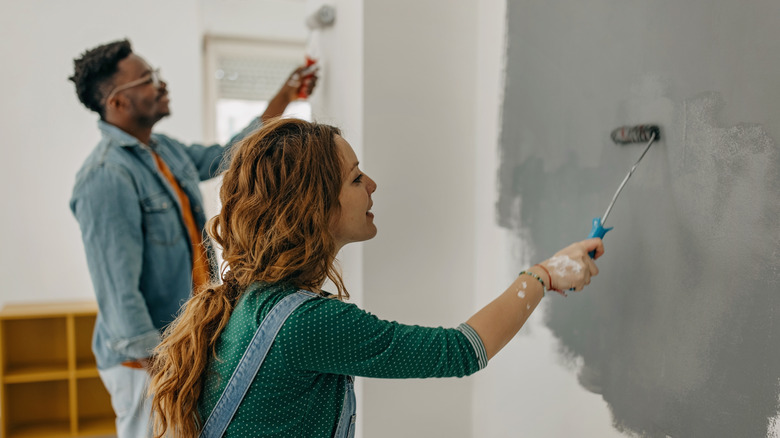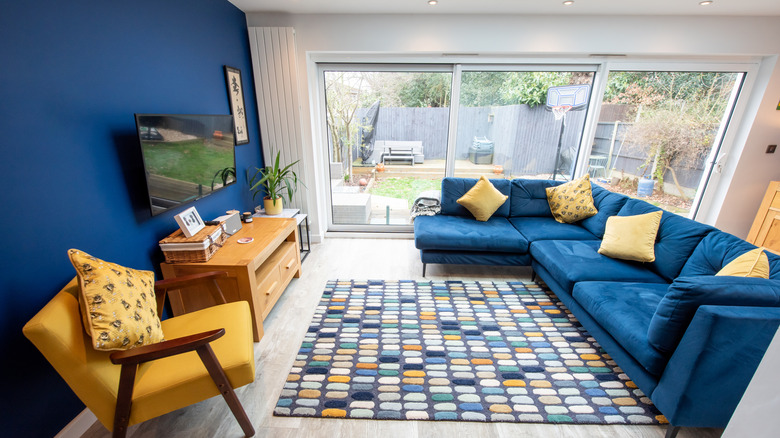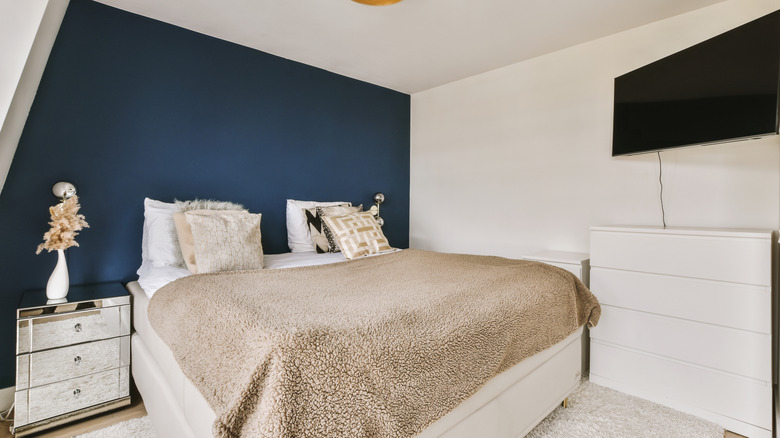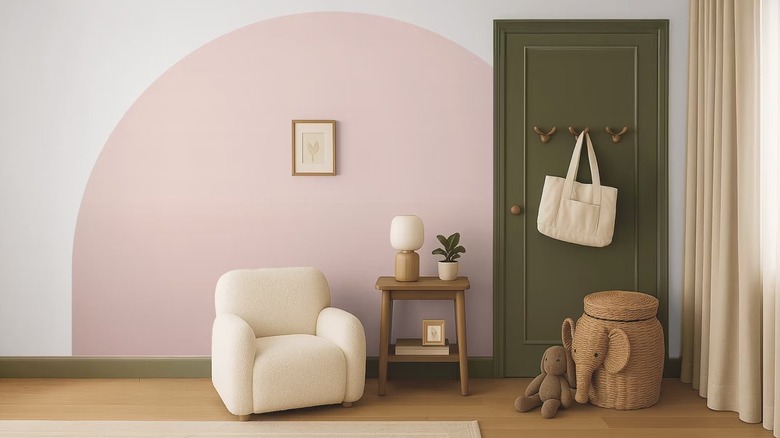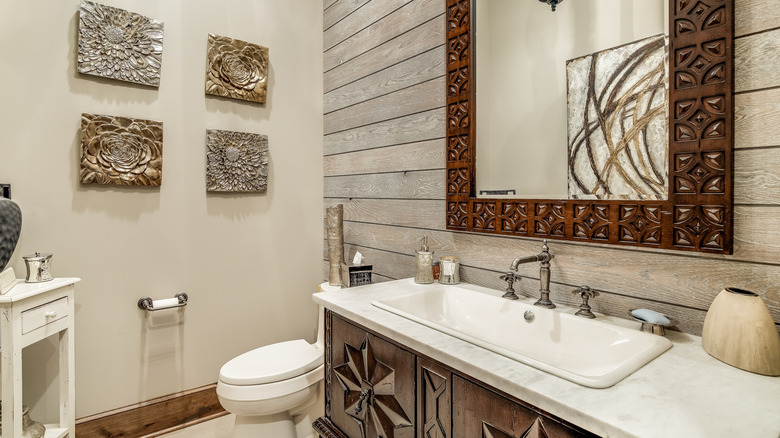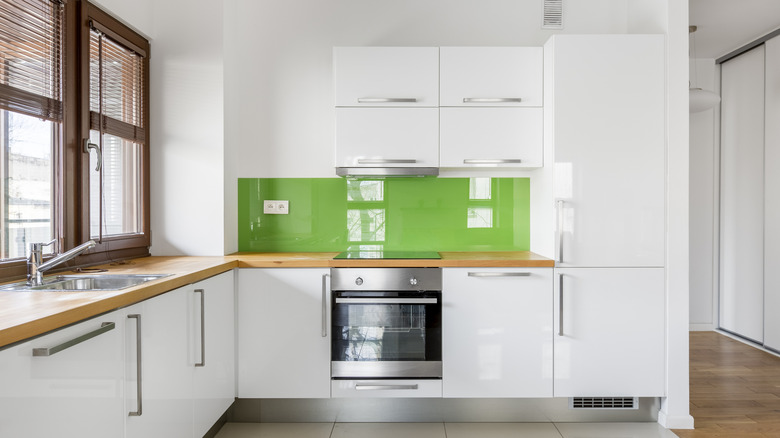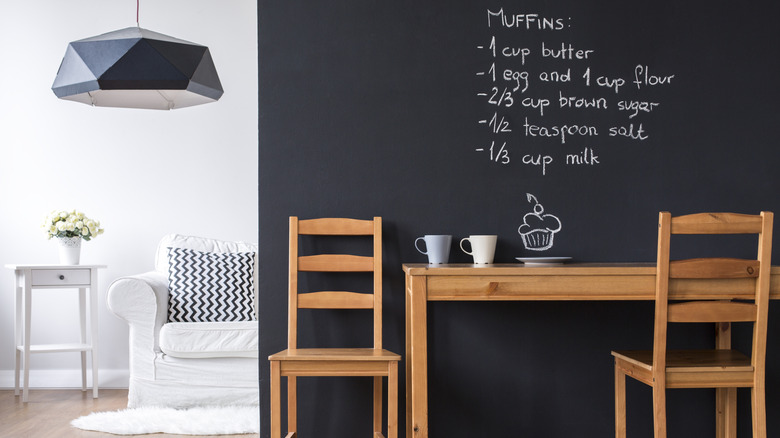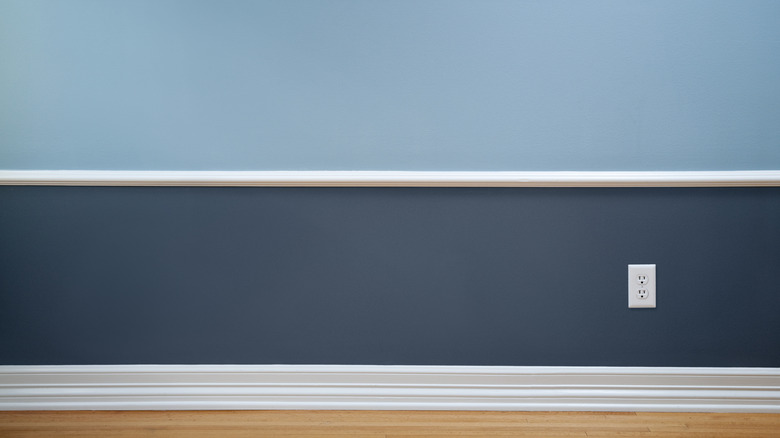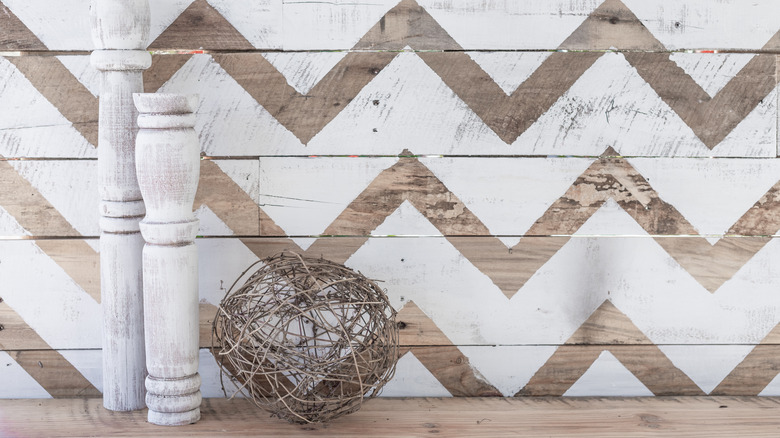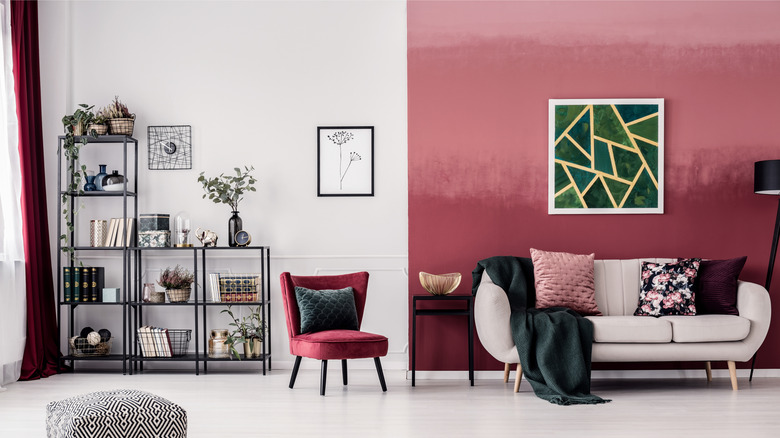10 Painted Accent Wall Trends That Are On Their Way Out, And What To Do Instead
An accent wall has been a go-to interior design choice to incorporate color without committing to a full paint job. In some form, accent walls will probably always endure, at the very least because they're DIY- and wallet-friendly. However, just like with any popular design feature, there are stylish ways to use them and others that feel outdated. With recent trends moving toward more cohesive, layered interiors, bold accent walls can feel too stark. We exclusively spoke to interior designers, and they revealed the painted accent wall concepts that are on their way out. For inspiration, they also described some alternatives that feel a little more fresh.
In an exclusive interview with House Digest, Christopher Boutlier, owner and principal interior designer of Christopher Boutlier Interiors explains, "Accent walls have become one of those default design moves. For a long time, they were seen as a way to add personality or energy to a space without overcommitting. But like any trend, some versions have overstayed their welcome." Many of the experts we interviewed agreed that the statement-making features still have a place (and we've rounded up accent wall ideas you'll start seeing everywhere this year). But like with any design choice, execution matters. Keep reading to learn what accent wall ideas to skip, and discover elevated alternatives you can try instead.
Accent walls with no architectural context fragment rooms and are fading from popularity
Picture an accent wall and you'll probably think of a wall painted a conspicuous color from the rest of the room. This is the easiest way to incorporate the concept into a home, but it's past its peak in popularity. In an exclusive interview with House Digest, Cathleen Gruver, lead interior designer at Gruver Cooley, explains, "Painted accent walls, particularly those in a bold color with no architectural context, are starting to feel dated. The trend of painting just one wall in a room a different color — often out of fear of going "too bold"—tends to break up the space visually rather than enhance it."
It may seem counterintuitive, but sticking to one color for the whole space can create a more impressive effect. Gruver explains, "Instead, we're seeing a move toward whole-room treatments — what we often refer to as color drenching, where walls, trim, and even ceilings are enveloped in a single hue. This creates a more cohesive, intentional, and immersive environment. It also allows the architecture, furnishings, and lighting to shine without a single wall visually shouting for attention."
Importantly, Gruver is not against accent walls as a whole. She just urges homeowners to consider what they bring to the room, explaining "There are still thoughtful ways to use accent walls — just not with paint alone. We might incorporate a wood slat detail, a dramatic tile installation, or even a custom wallpaper mural if it truly adds depth and texture to the space. But even then, it's about the materiality and integration, not simply a painted wall for the sake of trend." This idea aligns with today's trend towards more layered aesthetics. An accent wall that complements the rest of the room can look nicer than one that clashes for the purpose of standing out. If you're still looking for that bold pop, use texture or pattern to your advantage (like with vivid tile or detailed wallpaper) to create an accent wall that adds dimension and character.
One bold wall behind the bed has become boring
In a bedroom, a common spot for a painted accent wall is behind the bed. It makes sense in some ways, anchoring the bed visually to that wall. However, it's another option that has become quite overdone. Boutlier tells us, "This was once the go-to move in bedrooms. A deep navy or emerald wall behind the headboard, usually with the rest of the room left neutral. But now it tends to feel like a one-note gesture."
Again, this kind of accent wall can feel like it's breaking up and dividing the space rather than making it more cohesive. As an alternative, Boutlier also recommends color drenching, a painting trend that can boost the tranquility of a room. He explains, "If the goal is to create mood, I'd rather see the entire room wrapped in color. Painting all four walls and even the ceiling in a rich, cocooning hue gives the space real depth." This painting decision can really tie a room together.
If you are after contrast rather than cohesiveness, there are options other than a generic painted accent wall. For example, if you go for a color-drenched paint job, you can choose furniture, curtains, bed linens, or a rug in a contrasting color. You can also add more creative contrast with texture. Boutlier suggests, "Or skip the paint entirely and create contrast with material: an upholstered headboard wall, natural wood planking, or even a textural plaster finish will always feel more layered."
Graphic shapes and painted arches are anything but everlasting
Boho painted arches and playful geometric shapes are another accent wall trend that's past its prime. In part, they were popular because they are even easier to DIY than painting an entire wall. While they do add a pop of color to a room, they majorly lack dimension. Boutlier says, "These started popping up everywhere during the DIY boom. Painted arches behind nightstands or color-blocked shapes in the corners of a living room. While they might look playful in a photo, they rarely hold up in real rooms." These arches and shapes can feel out-of-place and pasted on in real life. Their playfulness can also come across as juvenile.
There's a different way to add small pops of color to walls, without jumping to bright shapes. Boutlier notes, "Instead, I suggest using color to respond to the architecture. Paint the trim in a slightly deeper tone than the walls, or carry color across door frames and ceilings to create a sense of cohesion. It's still creative, but much more elevated." Colorful arches or shapes can still make sense if you're following the shape of the wall, for example, if you have a recessed arched or rectangular nook, you can choose to paint it an accent color. Consider color-drenching the nook (painting the sides as well as the back) to make it look enveloping and unified.
Painted brick or shiplap feature walls has become stale and predictable
Painted brick and shiplap accent walls were widely trending in farmhouse and modern rustic homes. Picture contemporary but cozy rooms with a white brick or shiplap wall to brighten the space up. It does this function well, but it's been seen so often that it can feel generic, bordering on boring. Boutlier explains, "There was a time when painting exposed brick or shiplap a crisp white or soft gray gave a room that updated farmhouse look. But now it feels a little too expected." With design trends leaning toward more layers and textures rather than stark minimalism, these light-painted walls can feel dull.
Boutlier suggests taking advantage of the natural texture and color of the brick or shiplap material, noting, "If you have original materials, let them be what they are. A soft limewash or mineral-based paint will still give you a refined look, but it allows the texture to breathe. It's less about covering the material and more about celebrating it in a quieter way." If your brick is already covered, there are easy ways to get paint off of brick walls to bring them back to their original glory. And, sanding down a wall of painted shiplap and coating it with a warm natural stain is a weekend project that can make a big impact.
High-gloss lacquer walls no longer feel glamorous
Glossy, lacquered accent walls had their moment for their boldness, drama, and feeling of luxury. Their mirror-like finish brought a regular accent wall to the next level. Plus, they were well-suited for ultra-minimalist and very modern spaces that were popular at the time. But their boldness can be an Achilles heel — they can also stick out like a sore thumb. Boutlier says, "A single lacquered wall in a high-gloss finish used to feel glamorous and bold. But too often it reads as disconnected from the rest of the space." On top of a different accent wall color, the glossiness adds another layer of contrast and separation that can disconnect it from the other walls.
A similar look can be achieved with some subtlety. Instead of covering an entire accent wall, choose a smaller area or incorporate it through furniture pieces. Boutlier says, "If you want shine, be strategic. A lacquered ceiling in a small vestibule or a custom glossy bar cabinet can still feel luxurious. But across an entire wall, it can easily cross into theatrical." Paint choice also matters and you don't need to go for the full shine of lacquer. Boutlier suggests, "For a more current take, try a satin plaster finish or a soft sheen paint. The light still moves, but the effect is much more restrained." A subtler sheen can still bring some drama but in an elegant and understated way.
Chalkboard accent walls can look messy and very 2010s
Chalkboard accent walls were another idea that gained popularity in the last couple of decades. They were easy to DIY and they do have some fun benefits, mainly that you can draw on them and display chalk art, grocery lists, or other notes that you can erase whenever you please. But in reality, how often do they really look nice? If you don't have an artistic hand, they're more likely to be covered in half-baked drawings. In an exclusive interview with House Digest, Raydoor Sliding Walls & Doors Designer Jo Rich says, "A painted accent trend that is really starting to feel dated is the full height chalkboard wall. At one point it was extremely popular for people looking for notes and doodles but it quickly became messy." Not just messy in looks, either. The real reason you might regret that chalkboard wall is the grime that chalk leaves behind. Chalk dust can be a major hassle, especially if it gets into carpets or on furniture.
You don't have to lose a drawing or writing surface entirely, it just doesn't need to be a whole accent wall. Rich says, "Instead, I recommend using framed chalkboard panels or a magnetic writer's slate in a kitchen or home office. I find this offers the same functionality but feels more intentional and sculptural." These options are also easier to maintain (there's less surface area to clean when you want to draw something else) and are simpler to remove if you decide you want to try something new. If you have a chalkboard wall you're ready to be rid of, here's the easiest way to paint over your chalkboard wall.
Two-toned accent walls are a bit basic
Torn between two accent wall colors? Two-toned accent walls have often been the solution. This trend involved separating the wall horizontally and choosing a different color for each section. Rich explains, "Another look that has lost momentum is the half-wall 'dipped' paint. This look is where walls are split horizontally into two contrasting colors. I find that it can read as overly simplistic and divides the room awkwardly." As a standalone accent wall, this design trend tended to cut the wall at a nonsensical spot. Now, with a bit of trim or paneling, this idea can make more sense. But again, it can feel very disruptive to the flow of the room when done as a single accent wall.
Instead of cutting a wall in half with color, choose features that make more sense to paint. Rich recommends, "In my opinion, a fresher alternative is to paint only a recessed niche, bookcase backing, or mantel wall in your accent hue, which adds depth without cutting the wall in half and draws the eye to a specific feature." You can still choose two-tone designs with these applications. For example, paint different features in two coordinating hues, like a slate blue nook and a navy mantel.
Chevron and herringbone paint effects were fun, but they now scream DIY
Put simply, chevron and herringbone-patterned accent walls are overdone. They became so popular during a certain era (around the 2010s) that they're directly associated with that time. Too far back in time to be modern, but too close to today to have vintage charm, chevron and herringbone decor just feel outdated. In an exclusive interview with House Digest, Jamilyn Trainor, senior project manager and owner at Müller Expo Services International explains, "This can be visually striking, but has been used and abused in DIY decor and turns stale fairly quick." Instead, she suggests combining colors in a more subtle way like using a brushed limewash technique.
We also spoke exclusively with Farook Member, director at QS Supplies. He agrees, saying "Chevron and herringbone paint effects were once a staple of DIY interior design culture, but they've already passed their sell-by date. While they imparted movement and energy, now they have the potential to be too stylized and will clash with other more contemporary interior design elements." Today's wall decoration trends lean softer and less geometric, so he also recommends textured, subtler alternatives like textured paints and the brushed limewash suggested by Trainor. He explains, "These finishes create a handcrafted, organic aesthetic that's infinitely more subtle. They allow the wall to have something to say without screaming in the whole room. It's these subtle, haptic finishes that are going to be the future of interior design; they're timeless, versatile, and full of character." These ideas add more movement than you would get from a simple coat of paint, but without reverting to a blocky and loud design.
Ultra-moody accent walls in black or dark gray can feel overdone
A dark and moody accent wall adds alluring drama to a room. There's no need to limit yourself to black and gray though. There are so many more shades that can give you that dark and brooding look while bringing more dimension. Member explains, "Dark charcoal or black accent walls were once the marks of high drama and style-led design, but in practice, they tend to make a room feel closed in quickly, especially those without natural light. Moody colors are still wildly on-trend, but their application is more thoughtful." Certain black and gray shades can almost feel like they're swallowing the light in the room, which isn't ideal if you're going for a warm and cozy aesthetic.
There are nicer ways to create a moody atmosphere, and they still involve using dark paint. Member expands on this idea, explaining, "Moody colors are still wildly on-trend, but their application is more thoughtful. Ideally, I like to see clients employ rich, earthy shades like olive, rust, or deep clay in matte finishes to preserve depth but add warmth. These shades create intimacy without the weight black walls will inevitably bring. And they work well with natural textures like rattan, linen, and wood, which constitute the backbone of modern interiors. A dark wall can be dramatic, but the art now is in softness and subtlety, not jarring contrast." Popular hues like Umber Rust by Sherwin Williams and Dark Olive by Benjamin Moore can make the space look cozy rather than dramatic and dim.
Ombré accent walls will clearly time-stamp your space
Similar to bold chevron patterns, ombré effects also time-stamp your space to the mid-2010's. It's another trend that's associated with a past decade that it feels overdone and outdated. Rich describes it succinctly, saying "Gradient or ombré walls were popular for a few seasons, but now the soft fades often feel too whimsical and dated." A brightly-colored ombré wall can feel more like it belongs in a dorm room than a living room or bedroom.
If you still want something playful, go for more distinct shapes rather than a colorful fade. Think modern art style, with strategically-placed designs. Rich suggests, "I would instead try a geometric mural like bold triangles or an angular color block confined to one corner. I find it to be a more contemporary statement that is much easier to update. It keeps the accent localized and looks more modern than a full-wall gradient." Geometric accent walls can also be difficult to execute in a stylish way, and there are some differences between a timeless or trendy geometric accent wall. Instead of using paint or wallpaper, a geometric upgrade using ceramic tiles can look a lot more modern.
